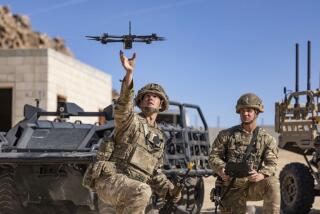Drone trade group adopts guidelines for flying in U.S. airspace
- Share via
An expected proliferation of unmanned aircraft in U.S. skies over the next few years is generating concern among civil libertarians and citizens about safety and privacy, and the nation’s drone makers are taking heed.
The Assn. for Unmanned Vehicle Systems International in Arlington, Va., has published a code of conduct for manufacturers and operators of the thousands of drone aircraft that are expected to be flying in U.S. airspace by 2015.
“We want everybody to know that this technology will be handled safely and with the utmost respect to individuals’ privacy,” said Ben Gielow, the association’s general counsel and government relations manager. “Ultimately, public confidence is needed in fielding these systems.”
But critics are unimpressed. Unresolved, they say, are worries about how commercial planes and small, low-flying drones can safely share the same airspace. Also, there are privacy concerns about the drones’ use of high-powered cameras as they fly above backyard pool parties and other private activities.
The San Francisco digital legal advocacy group Electronic Frontier Foundation shares those concerns. Jennifer Lynch, attorney with the foundation, said the code is ambitious but limited.
It “does not go far enough to recognize the very real threat to privacy posed by surveillance drones flying in the U.S. and makes no actual and enforceable commitments to protect individuals’ civil liberties and privacy rights,” she said.
The two-page code recommends when and by whom drones should be flown to minimize risk. It also calls on drone operators to comply with all federal, state and local laws and to cooperate with authorities at all levels. In addition, the guidelines commit to respecting other users of the airspace, the privacy of individuals and the concerns of the public and to improving public awareness.
The guidelines come at a time when the federal government is drawing up rules and regulations on how and where drones should be operated.
Currently, drones are not allowed to fly in the U.S. except with special permission from the Federal Aviation Administration. But as technology becomes more advanced and demand increases for using drones in the commercial world, the FAA has worked to ease restrictions. It aims for drones to be fully integrated into national airspace by September 2015.
The first drones that will probably be allowed in U.S. airspace are small aircraft that can be used for high-altitude photography, including video and surveillance. Some drones may resemble the large model aircraft that now buzz above parks.
Signing the code of conduct is voluntary for the association’s members, which include drone manufacturers such as Boeing Co., Northrop Grumman Corp. and AeroVironment Inc. of Monrovia.
Boeing has already backed the document.
“We stand behind the principles set forth in AUVSI’s code of conduct, which are critical for the proper testing, advancement and integration of unmanned airborne systems into the national airspace,” the Chicago company said in a statement.
Looking to take the next step in integrating drones into U.S. airspace, the FAA is in the process of picking six unmanned aircraft system test sites by the end of the year.
In March, the FAA asked for public comments on the selection process. During that 60-day period, it received more than 220 comments on its website.
More to Read
Sign up for Essential California
The most important California stories and recommendations in your inbox every morning.
You may occasionally receive promotional content from the Los Angeles Times.











